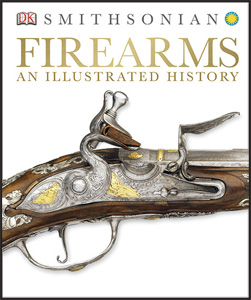Review by Joseph P. Tartaro | Executive Editor
SMITHSONIAN FIREARMS: AN ILLUSTRATED HISTORY. ©2014. Published by DK Books, 345 Hudson St., Floor 4, Dept. TGM, New York, NY 10014. phone: 646-674-4112. Oversized hardcover, 320-pages, lavishly illustrated. Price: $40.
 If you’ve never seen the Smithsonian’s arms and armor collection, you’re in for a treat with this beautifully illustrated volume put together under the guidance of some of the world’s leading arms museum curators. Even if you have examined some of the Smithsonian’s arms collection, you probably will not have seen all the firearms in this book, as no museum, even the world’s largest, cannot often display all of the items in its collection.
If you’ve never seen the Smithsonian’s arms and armor collection, you’re in for a treat with this beautifully illustrated volume put together under the guidance of some of the world’s leading arms museum curators. Even if you have examined some of the Smithsonian’s arms collection, you probably will not have seen all the firearms in this book, as no museum, even the world’s largest, cannot often display all of the items in its collection.
This book gives you exactly that kind of experience, organizing the guns through some 700 years of history, grouped in period subcategories, so you get a chance to discover them in progressive historical tour. And what a tour!
The photo reproductions in this book are nothing short of amazing. They are sharp in every detail and they are reproduced using a “varnished” process that makes them stand out from the pages. Frankly, if this book had not been printed in China, it would cost at least five times its price. The quality of the paper and the print is that good (and you can take that from someone who’s been around the printing business for many decades.)
This history of arms begins at the beginning with the earliest cannon, then harquebuses and matchlocks for combat and sports, then progresses chapter by chapter through the flintlock years, the 1830 to 1880 “age of change” before progressing to the firearms developed for “A World in Conflict” from 1880 to 1945, and then on to the present day.
Of course there are machineguns, modern designs like the AK and AR families of arms, plus many other current models in use by the military, law enforcement, competitors and hunters around the world.
The latest machine pistols are also included, and so are many of the odd contrivances and disguised guns that were developed for clandestine forces of the 20th and 21st centuries.
The photos are accompanied by brief text, but then some classes of arms are set aside for more detailed explanatory copy, with photos of operational and design features. The detailed explanations of the MAC 10 are a good example.
Finally, there are, besides a glossary, index and acknowledgement, a look at some key arms designers, and an explanation of how guns through the centuries really work, and of the ammunition they employed.
If you are still not convinced that a copy of this book belongs in the collection of every serious student of firearms, drop by a book store and just peak into a display copy. I’d be surprised if you leave it in the store.



